Intel Core i9-13900K and i5-13600K Review: Raptor Lake Brings More Bite
by Gavin Bonshor on October 20, 2022 9:00 AM ESTCPU Benchmark Performance: Rendering And Encoding
Rendering tests, compared to others, are often a little more simple to digest and automate. All the tests put out some sort of score or time, usually in an obtainable way that makes it fairly easy to extract. These tests are some of the most strenuous in our list, due to the highly threaded nature of rendering and ray-tracing, and can draw a lot of power.
If a system is not properly configured to deal with the thermal requirements of the processor, the rendering benchmarks are where it would show most easily as the frequency drops over a sustained period of time. Most benchmarks in this case are re-run several times, and the key to this is having an appropriate idle/wait time between benchmarks to allow for temperatures to normalize from the last test.
One of the interesting elements of modern processors is encoding performance. This covers two main areas: encryption/decryption for secure data transfer, and video transcoding from one video format to another.
In the encrypt/decrypt scenario, how data is transferred and by what mechanism is pertinent to on-the-fly encryption of sensitive data - a process by which more modern devices are leaning to for software security.
We are using DDR5 memory on the Core i9-13900K, the Core i5-13600K, the Ryzen 9 7950X, and Ryzen 5 7600X, as well as Intel's 12th Gen (Alder Lake) processors at the following settings:
- DDR5-5600B CL46 - Intel 13th Gen
- DDR5-5200 CL44 - Ryzen 7000
- DDR5-4800 (B) CL40 - Intel 12th Gen
All other CPUs such as Ryzen 5000 and 3000 were tested at the relevant JEDEC settings as per the processor's individual memory support with DDR4.
Rendering
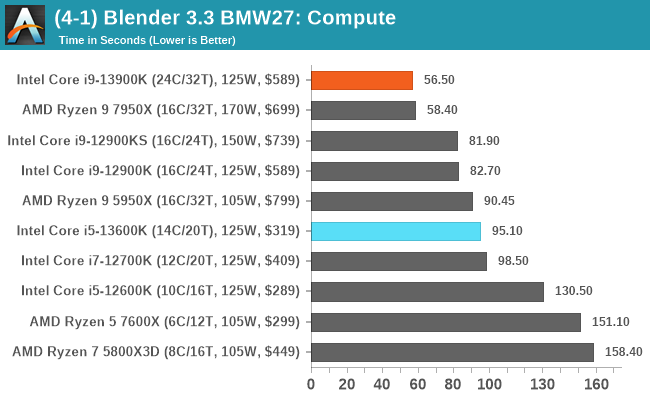
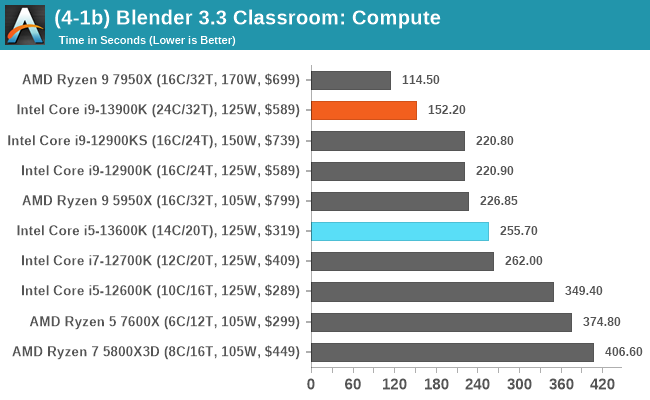
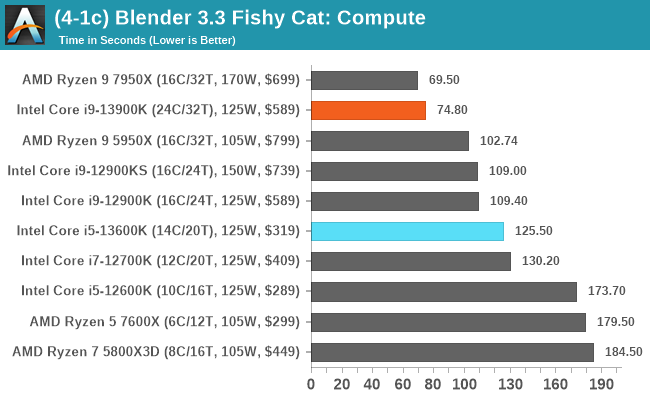
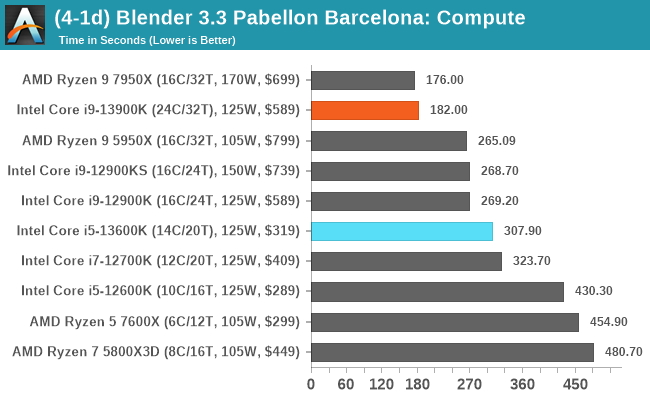
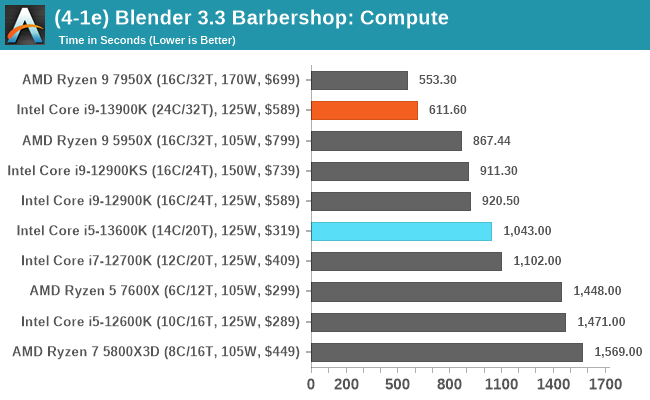

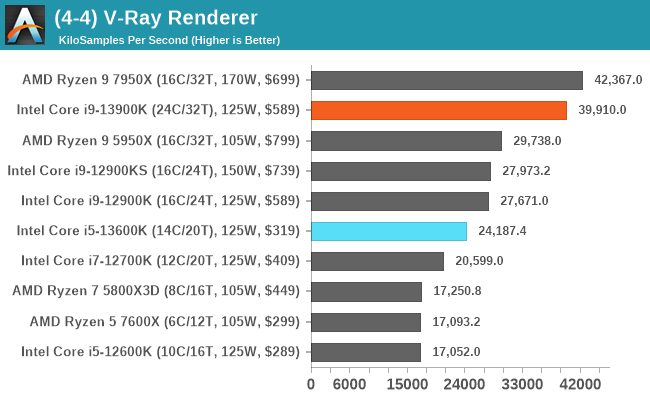
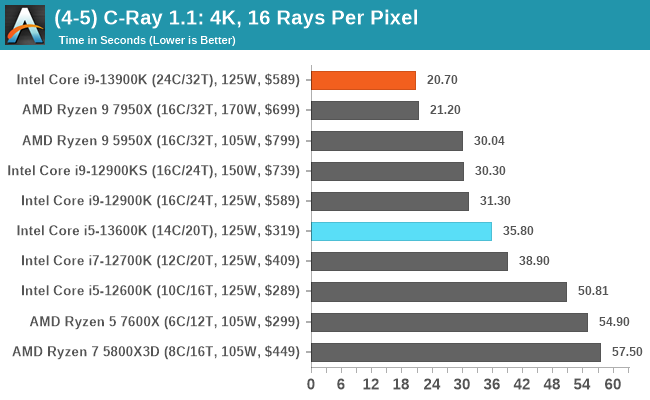
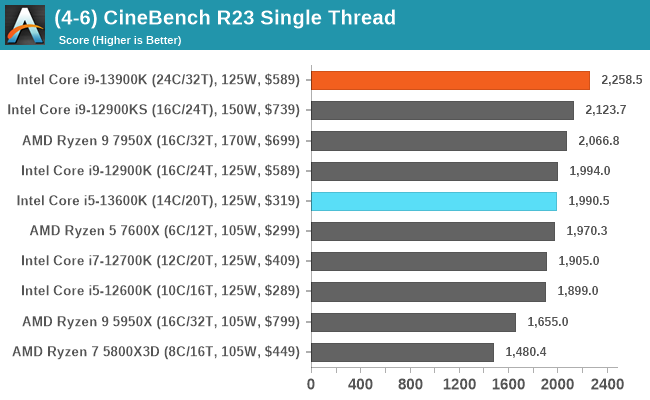

Identifying what core comes where in our rendering tests, both the Core i9-13900K and Ryzen 9 7950X sit comfortably at the top of the tree. Depending on the test, it’s a consistent battle for rendering supremacy. Where things aren’t as close are in our POV-Ray and V-Ray tests, where the Core i9-13900K has a distinct advantage; likely down to having eight more logical cores than the 7950X.
Encoding
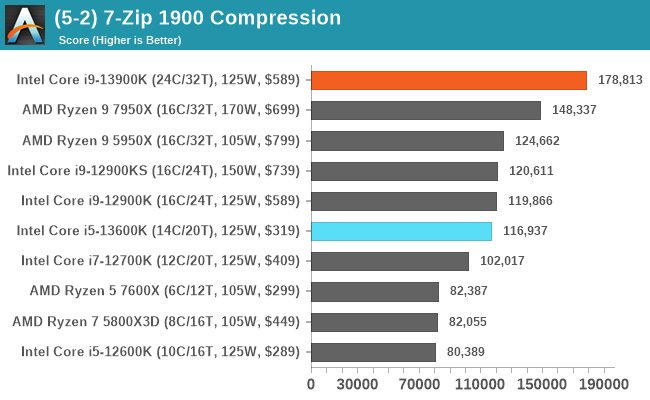
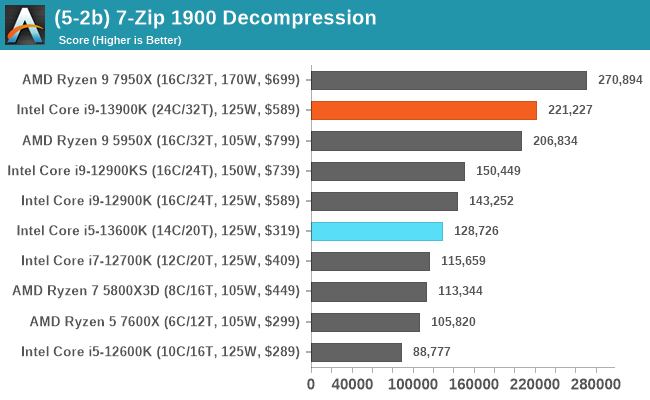

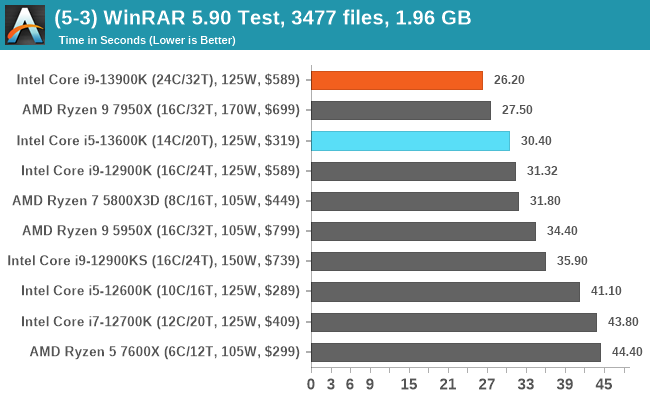
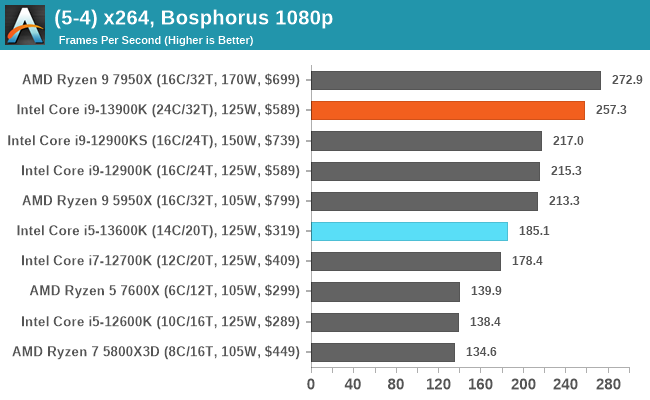
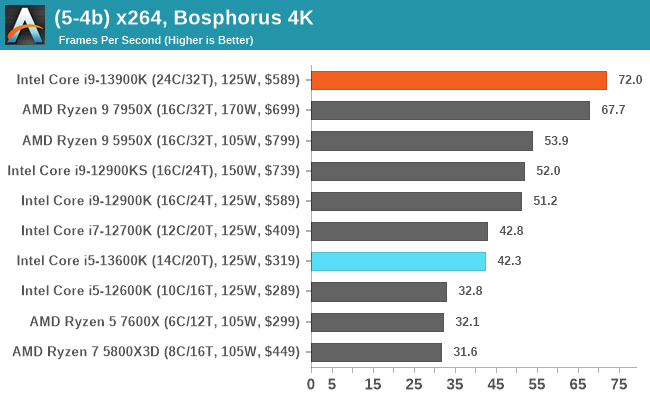
In our encoding tests, interestingly the Core i9-13900K looks to have the advantage in compressing files with 7-Zip. It’s a little different for AMD as the Ryzen 9 7950X decompresses the data better, with the overall combined advantage going to AMD in this particular test. In our updated x264 benchmark, Intel takes the lead in 4K encoding, while AMD has the lead in 1080p encoding; both are equally viable options, however.










169 Comments
View All Comments
Nero3000 - Thursday, October 20, 2022 - link
Correction: the 12600k is 6P+4E - table on first pageHixbot - Thursday, October 20, 2022 - link
I am hoping for an high frequency 8 core i5 with zero ecores and high cache. It's would be a gamer sweet spot, and could counter the inevitable 3d cache Zen 4.nandnandnand - Friday, October 21, 2022 - link
big.LITTLE isn't going away. It's in a billion smartphones, and it will be in most of Intel's consumer CPUs going forward.Just grab your 7800X3D, before AMD does its own big/small implementation with Zen 5.
HarryVoyager - Friday, October 21, 2022 - link
Honestly, I'm underwhelmed by Intel's current big.LITTLE setup. As near as I can tell, under load the E cores are considerably less efficient than the P cores are, and currently just seem to be there so Intel can claim multi-threading victories with less die space.And with the CPU's heat limits, it just seems to be pushing the chip into thermal throttling even faster.
Hopefully future big.LITTLE implementations are better.
nandnandnand - Friday, October 21, 2022 - link
Meteor Lake will bring Redwood Cove to replace Golden/Raptor Cove, and Crestmont to replace Gracemont. Gracemont in Raptor Lake is the same as in Alder Lake except for more cache, IIRC. All of this will be on "Intel 4" instead of "Intel 7", and the core count might be 8+16 again.Put it all together and it should have a lot of breathing room compared to the 13900K(S).
8+32 will be the ultimate test of small cores, but they're already migrating on down to the cheaper chips like the 13400/13500.
Hixbot - Saturday, October 22, 2022 - link
Yes it does seem backwards that the more efficient architecture is in the P core. Reducing power consumption for light tasks seems better to keep it on the P core and downclock. I don't see the point of the "e" cores as effiency, but rather academic multithreaded benchmark war. Which isn't serving the consumer at all.deil - Monday, October 24, 2022 - link
E is still useful, as you get 8/8 cores in space where you could cram 2/4. I agree E for efficiency should be B as background to make it clearer what's the point. They are good for consumers as they offer all the high speed cores for main process, so OS and other things dont slow down.I am not sure if you followed, but intel cpu's literally doubled in power since they appeared, and at ~25% utilization, cpu's halved power usage. What you should complain about is bad software support, as this is not something that happens in the background.
TEAMSWITCHER - Monday, October 24, 2022 - link
I don't think you are fully grasping the results of the benchmarks. Compute/Rendering scores prove that e-cores can tackle heavy work loads. Often trading blows with AMD's all P-Core 7950X, and costing less at the same time. AMD needs to lower all prices immediately.haoyangw - Monday, October 24, 2022 - link
That's an oversimplification actually, P-cores and E-cores are both efficient, just for different tasks. The main efficiency gain of P-cores is it's much much faster than E-cores for larger tasks. Between 3 and 4GHz, P-cores are so fast they finish tasks much earlier than e-cores so total energy drawn is lower. But E-cores are efficient too, just for simple tasks(at low clockspeeds). Below 3GHz and above 1GHz, e-cores are much more efficient, beating P-cores in performance while drawing less power.Source: https://chipsandcheese.com/2022/01/28/alder-lakes-...
Great_Scott - Friday, November 25, 2022 - link
Big.LITTLE is hard to do, and ARM took ages and a lot of optimization before phone CPUs got much benefit from it.The problem of the LITTLE cores not adding anything in the way of power efficiency is well-known.
I'm saddened that Intel is dropping their own winning formula of "race-to-sleep" that they've successfully used for decades for aping something objectivly worse because they're a little behind in die shrinking.